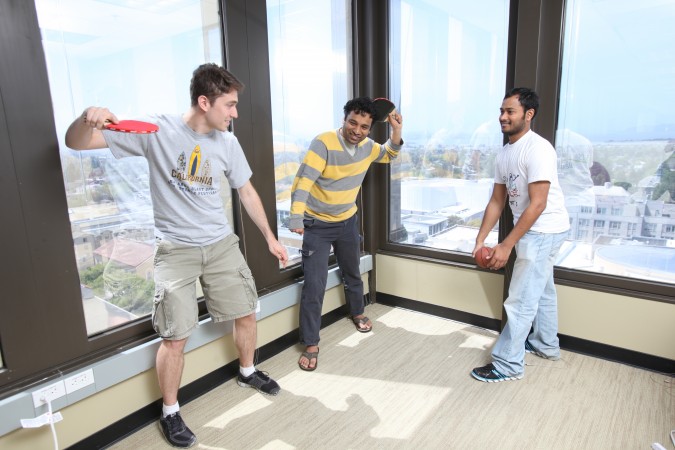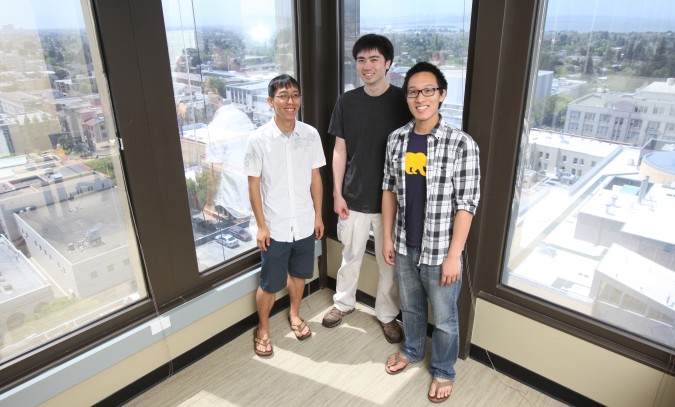Archive for the ‘Eliot Sun’ tag
I meet the Picatcha.com team at the University of California Berkeley Skydeck startup accelerator

Picatcha.com team playing ping pong with a basketball. May 2, 2012, at University of California Berkeley Skydeck startup accelerator. Photograph by Kevin Warnock.
On May 2, 2012 I met with Satish Polisetti, Dhawal Mujumdar and Sean Carey of Picatcha.
Picatcha is a made up word combining ‘picture’ and ‘Captcha.’
Captcha stands for Computer Automated Public Turing Test to tell Computers and Humans Apart. Captchas were invented by researchers at Carnegie Mellon University.
Even if you don’t recognize the word captcha, you know the test. Here’s an example of Captcha used by Facebook [where I encourage you to subscribe to my posts]:
This Captcha was posted to the photo sharing site Flickr because the first word is difficult to read. You can see Flickr user Chance Abbatoir couldn’t make out the word and wrote wtf? in its place. Wtf is short for ‘what the fuck’ for my readers who aren’t familiar with this slang term.
This illustrates the problem Picatcha is trying to solve.
Regular Captchas similar to the example from Facebook here are too easy for computers to figure out. That allows bad guys to do things they should not do, like buy hot concert tickets as soon as they go on sale, bumping out actual people by overwhelming the websites where the tickets are sold, such as at TicketMaster and Live Nation. The ticket sites assume the buyers are legitimate because the Captchas are correctly deciphered. As a result, more concert goers have to buy their tickets at inflated prices on the secondary market.
In response to such fraud against web properties, traditional Captchas are getting more difficult for humans to solve, such as the one shown here from Facebook. I suspect it says ‘N 1/4’ but I can’t be certain. Can you?
Computers and software are improving. There’s an arms race between conventional Captcha writers and the bad guys. The bad guys are winning.
Picatcha has a different approach.
Picatcha presents a challenge that’s currently difficult for a computer to solve.
The Picatcha twist is that users are asked to look at a set of images and identify the subset that matches a word. For example:
In this example the user has to click on the two middle pictures on the top row, and the second and last picture on the second row. Teaching a computer how to solve this puzzle is much harder than training optical character recognition software to decipher regular Captchas, according to Picatcha. Think about it from the computer’s perspective… the Picatcha way requires machine vision to identify arbitrary objects. OCR only has to deal with 26 letters and 10 digits. A computer trained to break Picatchas would have to handle a vast array of images, which could be crude line drawings up to detailed color photographs.
Picatcha does a lot of other things that make it more compelling than what I’ve so far described.
They allow customers to use images of their products in their picture captchas. Imagine how this would thrill consumer product companies. Imagine how personal this makes the test for users. Suddenly the access tests can become fun, not irritating.
You solve Picatchas by clicking or touching, not typing, making them much more friendly to solve from smart phones and tablets.
There’s extra tricky security happening under the covers, I was told, so this is not a quick programming project to duplicate.
Even more compelling is the Picatcha system can vary the images depending on who the user is. That’s right, the system can tap into your location and demographic data that Picatcha has access to via commercial ad serving services. This strikes me as a brilliant way to enhance user satisfaction and make it more likely they’ll sign up for or buy whatever is behind the Picatcha.
I am impressed with Picatcha. So were the semi-final round judges for the 2011 University of California Berkeley Business Plan Competition, hosted by The Lester Center for Entrepreneurship & Innovation and led by Executive Director André Marquis. Picatcha competed in that competition in 2011 and advanced to the elite final group of eight teams [Note to the Berkeley Business Plan Competition organizers: Keep these links valid in perpetuity. Right now it appears only two years of winners are identified at your site. All winners and finalists back to the 1999 inception of the competition should be listed. Thank you.]. Picatcha collected a cash prize for their efforts. It’s very, very difficult to advance to the finals in that competition… I know as I was a semi-final round judge in that competition. I was not a judge for Picatcha, as I served on the Products & Services track, and Picatcha competed on the Information Technology & Web track. I did not meet the Picatcha team last year at the finals, as I was not yet a tech blogger.
Picatcha started as a school project for Co-Founders Mujumdar and Polisetti when they were students at the School of Information at University of California, Berkeley. They described their work in an attractive summary report. Their Advisor was Bob Glushko.
Picatcha is a hosted service, so its customers don’t need to install any software on their web servers. According to the front page of the Picatcha website today, the company has served up over four million access tests so far, on over 200 customer websites.
When I was meeting with Co-Founder Dhawal Mujumdar last week, he showed me the Picatcha implementation for a brand so famous you are all but certain to have heard of it if you live where their product is sold — M & Ms, the chocolate candy from Mars that melts in your mouth, not on your hands.
Picatcha is sharing office space with other impressive startups at Skydeck, the startup accelerator at University of California at Berkeley, in Berkeley, California USA. I met the Picatcha team after I informed Eliot Sun from Kloudless, Inc. that I’d like him to introduce me to another team, as I had time before my next meeting, and I wanted to be productive. I’ve wrote about Kloudless yesterday, May 7, 2012. I took the pictures for this post. Click on them to see them at full 21 megapixel resolution. There are many more good shots of the Picatcha team playing basketball ping pong in a public album on my Facebook page.
Meet Kloudless.com, a UC Berkeley startup that’s bringing order to your Gmail attachments

Timothy Liu, Brian Tang and Eliot Sun - three of the four co-founders of Kloudless, Inc., May 2, 2012. Photo by Kevin Warnock.
On Tuesday, May 2, 2012, I met with Eliot Sun, co-founder and CEO at Kloudless, Inc., winner of the IT and Web track at the 2012 Berkeley Startup Competition.
Sun and his three co-founders, Timothy Liu, Brian Tang and Vinod Chandru, have built an impressive productivity utility for use with Gmail, Google’s web based email service. I didn’t get to meet Chandru, which is why he’s not pictured here, as I took all of these pictures. Click on them to see them full size.
Liu, Tang and Sun allowed me to photograph them in their corner cubicle of the University of California Startup Accelerator @Skydeck, commonly referred to around campus as simply Skydeck. Have a look at the sweeping view in the photographs here. That’s San Francisco’s skyline directly behind the heads of Tang and Sun. Click the picture and wait for it to load in a new window. Then click the picture again to see the full size version. You can clearly see the San Francisco Bay Bridge through the glass window.
The Skydeck is located on the penthouse floor of the tallest building in Berkeley, at 2150 Shattuck Avenue, Berkeley, California USA. This building is at the the top of the escalator from the circular exit to the Berkeley BART station.
Kloudless is still in private beta, and I have not personally used the service. But Sun did give me a great demonstration of the working site.
Eliot Sun knew up front that I am a blogger and that I would write this post.
Kloudless is targeted towards users that receive a lot of email with important attachments. Emails that contain attachments fill up email storage far faster than emails without attachments. Search in Gmail does not look inside attachments, according to Sun.
What Kloudless does is hard to believe hasn’t been done before, as it’s brilliant.
Kloudless has a plugin for Gmail that modifies the user’s options. A new option when one receives an email with an attachment is to move the attachment to that user’s account at either DropBox or Box, which are popular cloud storage services offered by two different companies.
If a Kloudless user directs the service to move the attachment file to DropBox or Box, the Kloudless service does so. What makes Kloudless deserving of winning competitions is that it remembers where it put the file. The next time the user views that email in Gmail, they won’t have the attachment directly available to them from Google. However, there will be a link to the file that is now stored in the cloud at either Box or DropBox. A file can be stored at both services at once, if the user so chooses.
Kloudless is storing the association between original email and the stored attachment now in the cloud outside of Google.
There is a screen in Kloudless where users can review all their attachments in a view that omits all the emails that did not have attachments originally. This condensed view is compelling, for its brevity. If a user finds a file they are interested in, that user can click back to the original email message that brought the file to them in the first place.
There’s a lot to like about the Kloudless business model. They are not a cloud storage provider, so they avoid having to store petabytes of data. They’re storing metadata, not attachments. Their own hosting costs should be moderate since they still have to pay for the bandwidth to move files around between Google and the cloud storage providers.
Kloudless is likely to be able to charge for this service, because it gives such useful control and quick access to users.
Users that embrace Kloudless are likely to stay customers forever, because if they quit the service, presumably they will lose their ability to associate their attachments with their emails, which could be painful.
Eliot Sun is a smart guy. He holds degrees in Mathematics and Economics as well as minors in Chinese and Latin, all from UC Berkeley. You don’t frequently find engineers that seriously studied Latin.
Sun’s three co-founders Timothy Liu, Brian Tang and Vinod Chandru also all graduated from UC Berkeley. Liu is CTO, Tang is Chief Scientist and Chandru is Vice President of Engineering.
Sun also had the smarts to get his name as a domain name, which everyone should do if they can. There’s no better beach front real estate for your personal brand than your own name followed by .com.
Global Brain Corporation, a venture capital firm in Japan, invited Sun to attend their annual Global Brian Alliance Forum in December, 2011. Sun spent four days meeting with potential partners and one day at the Forum. Sun’s Kloudless presentation at the Forum was judged the best pitch of the event.
On September 22, 2011, Kloudless won first place in the Plug and Play EXPO at the Plug and Play Tech Center.
Including the IT and Web track at the Berkeley Startup Competition last month, that’s three wins in less than six months, and Kloudless hasn’t even launched yet.
Kloudless is a company to watch.
PS – I posted 16 more shots from my photoshoot with three of the four Kloudless co-founders to my Facebook profile, where you can subscribe to my updates. I had my studio lights with me as I was on my way to a photoshoot with model Annika, from my blog post about AlbertMing, an early adopter of Skydeck’s services that’s since moved to their own office space in Berkeley.









